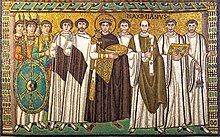History of the Later Roman Empire
The Roman Empire survived the crisis with minimal territorial losses: only Dacia to the north of the Lower Danube, and the Agri Decumates in the Black Forest region were abandoned in the 270s.
Significant Christian communities existed in the largest urban centers, like Rome, Antioch, Alexandria and Carthage, and their size quickly grew in the first half of the 3rd century.
Galerius forced the Persian king, Narseh to cede lands along the river Tigris to Rome and reimposed Roman suzerainty over the Kingdom of Iberia.
On this occasion, Galerius and Constantius Chlorus were promoted to the rank of Augustus, and two Illyrian military commanders, Maximinus Daia and Valerius Severus, were appointed as the new Caesars.
On the other hand, he prescribed that a slave nurse participating in a girl's abduction be punished with molten lead poured down her throat, and a woman who abandoned her husband was to be banished pennilessly to a remote island.
In four years, his "New Rome" was surrounded by walls enclosing about 600 hectares (1,500 acres) of land, and it was adorned with all elements of an imperial capital, including a palace and a large stadium.
Constantius made Gallus' younger half-brother Julian Caesar charging him with the command of Gaul and returned to Mesopotamia to repel a Persian invasion.
Although Picts, Scoti, Attacotti, Alemanni, Saxons, Quadi, Sarmatians and Goths launched regular raids across the imperial borders, the Roman army pacified the situation.
[42] Regarding them as potential recruits, Valens allowed them to settle in Thrace, but failure to provide ample amounts of food, and abuses by Roman officials outraged the Goths.
Constantine III appointed his son Constans to take command of the defence, but the general Gerotnius disobeyed and proclaimed one Maximus emperor in Tarraco.
As historian Peter Heather emphasizes, the Visigoths carried out "one of the most civilized sacks of a city ever witnessed", but their capture of the old capital shocked the Roman world.
After abandoning Rome, Alaric decided to conquer the wealthy northern African provinces, but a storm destroyed his fleet and he died in southern Italy.
Constantius restored Roman rule in southern and central Iberia and ceded Aquitania Secunda to the Visigoths in return for their assistance against the Vandals, Alans and Suebi.
In preparation for an invasion from the Eastern Roman Empire, John ordered the cura palatii ("curator of the palace") Flavius Aetius to hire Hunnic mercenary troops.
Aetius who had spent years with the Huns as a hostage succeeded, but by the time he returned to Italy, an Eastern Roman expeditionary force had defeated John's army.
[71][72] The Vandals and Alans suffered heavy losses during their fights with the Romans and Visigoths in Iberia and their king Gaiseric decided to guide them to northern Africa in 429.
The Eastern Roman general Aspar came to the rescue of Carthage, but Bonifatius was ordered to return to Italy, probably by Galla Placidia who needed his support against Aetius.
In two years the Eastern Roman reinforcements left Carthage and Valentinian concluded a peace treaty with the Vandals, acknowledging their acquisition of much of northern Africa.
Majorian restored imperial rule in Gaul and launched successful campaigns against the Visigoths and Suebi, but his position weakened after the Vandals crushed his fleet.
After a five-month interregnum, Gundobad acclaimed Glycerius, a court official, emperor, but Leo sent Marcellinus' nephew Julius Nepos to Rome to claim the imperial throne.
His mother-in-law Verina and her brother Basiliscus forced him to flee from Constantinople with the support of the Isaurian general Illus and the Ostrogothic leader Theoderic Strabo.
Unpaid Ostrogothic troops launched pillaging raids against the Balkan provinces and Theodoric Strabo nearly captured Constantinople before died in a riding accident in 481.
The Lower Danube remained barely defended, enabling Hunnic, Bulgar and Slavic groups to make frequent pillaging raids against the Balkan provinces.
[105] Justinian introduced harsh measures against rioters to restore public order in the major cities, and his officials implemented his laws with great vigour.
Theodoric's daughter, Amalasuntha, who ruled the Ostrogothic Kingdom in Italy as regent for her son Athalaric, allowed the Roman expeditionary forces to use the port of Syracuse during the campaign.
The pacification of the reconquered northern African territories lasted for years because of riots by unruly Berber tribes and their cooperations with rebellious Roman troops.
[117] Justinian, as historian Warren Treadgold emphasizes, "had added more land to the empire than any emperors but Trajan and Augustus",[118] but the preservation of the territorial status quo was a costly enterprise.
After Alboin was murdered in 573, ambitious Lombard chieftains continued the conquest, but central Italy, Naples, Calabria and Sicily remained under Roman rule.
[129] When a famine caused a riot in Constantinople in 602, Maurice ordered a Roman army to winter in Slavic territory, living off the land over the Danube, but the troops mutinied and proclaimed the centurion Phocas emperor.
Patriarch Cyrus of Alexandria offered a yearly tribute of 200,000 nomismata to the Arab general Amr ibn al-As for a truce and went to Constantinople to seek imperial confirmation.









